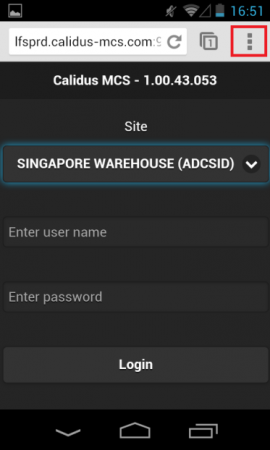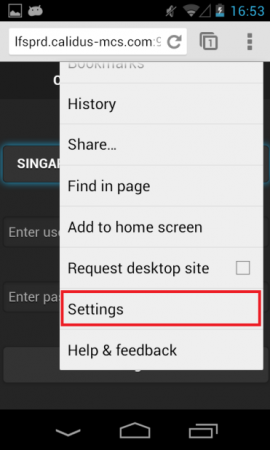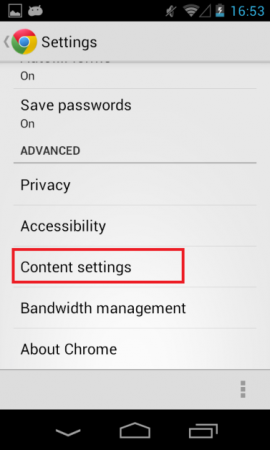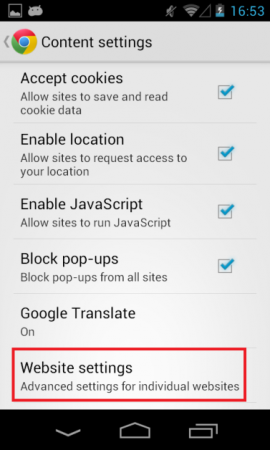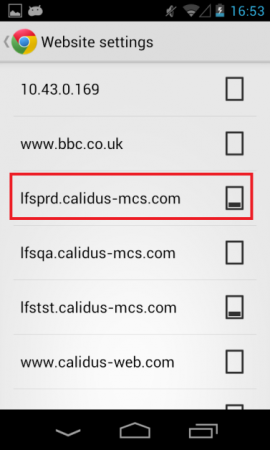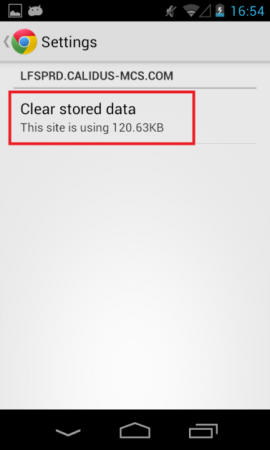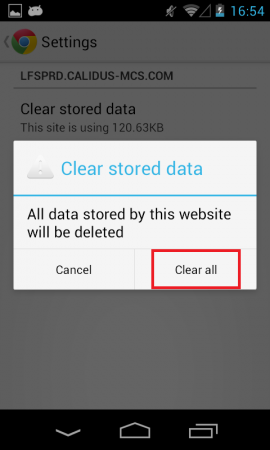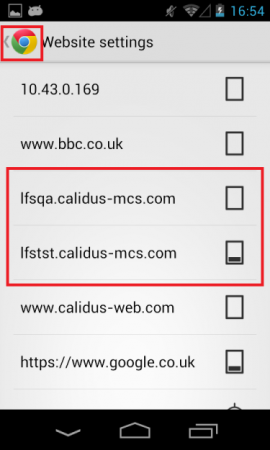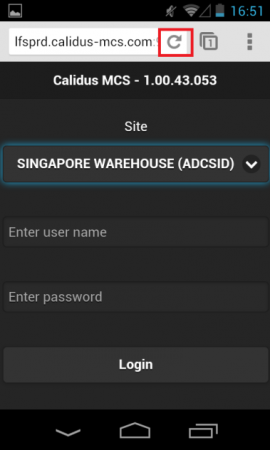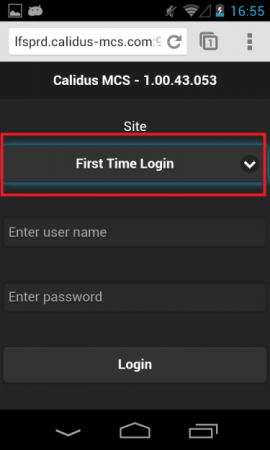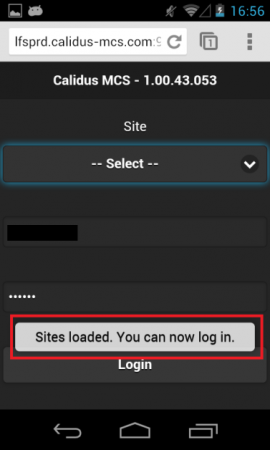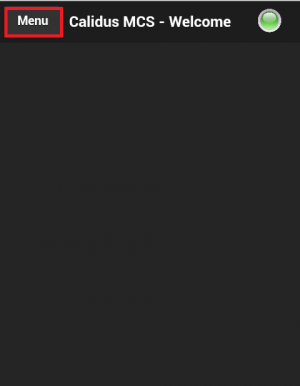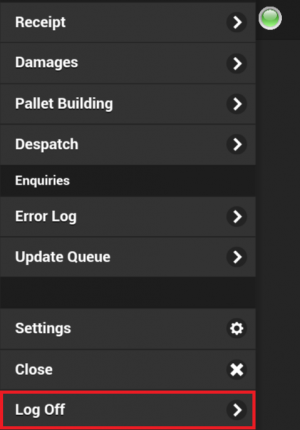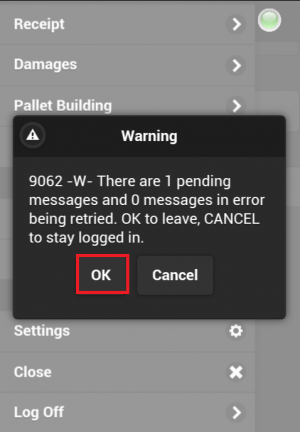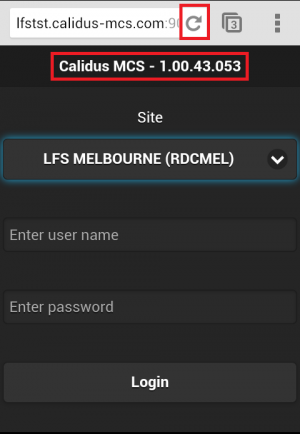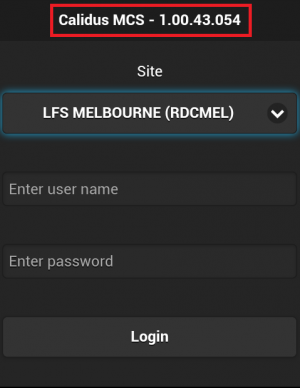OV 320722 CALIDUS MCS Device Advanced Guide
![]()
Aptean
CALIDUS MCS Device Advanced Guide
CALIDUS MCS
6th December 2019 - 2.00.03.007
Reference: UG 320722
Introduction
The purpose of this document is to document some actions that may be required from time to time when updating or maintaining your devices running CALIDUS MCS.
Device Cleardown
The process to clear the data from the PDA device is given in the steps below.
![]() Note: All work should be completed on the device before clearing down the device data.
Note: All work should be completed on the device before clearing down the device data.
Steps to Clear Down the Device
To clear down device data, the following steps should be taken (screenshots for guideline below):
- Open Chrome Browser on Device
- Take the Chrome Settings option in the top right of screen. (Opening Chrome settings menu).
- Take the 'Settings' option from the menu. (Scroll if necessary)
- Take the 'Content Settings' option, from the Advanced section (scroll if necessary).
- Choose the 'Website Settings' option.
- Click on your url, for example 'clientprd.calidus-mcs.com', an MCS Production URL option.
- Take the 'Clear Stored data' option.
- When prompted with Clear stored data, take option to 'Clear all'.
- Press back arrow in top left multiple times to return to MCS login screen. Note that the clientprd.calidus-mcs.com option is no longer visible in the website settings.
- Refresh the URL to update the settings.
- You will be prompted with First time login – login as usual to update system data.
- Select Site and Login as usual.
Refresh MCS
Overview
This is the user guide for the refreshing the browser to use the latest version of the CALIDUS MCS software. It shows updating from version 1.00.43.053 to 1.00.43.054.
CALIDUS MCS is a browser based application as is currently only supported with Google Chrome due to limitations of other web browsers.
Refreshing MCS
If logged into the CALIDUS MCS application, click Menu, scroll down and click Log Off.
On clicking Log Off if there are any Despatch or Receipt messages waiting to complete the user will be presented with a confirmation. Click OK to logoff.
![]() Note: Any Despatch or Receipt messages will resume after logging in.
Note: Any Despatch or Receipt messages will resume after logging in.
Once log off has completed check the current version number and click the browser’s refresh button
When the browser has refreshed the version number will have changed.
The user may now login.
Appendix A: Document References
A.1 References
| Ref No | Document Title & ID | Version | Date |
| 1 |
A.2 Glossary
| Term or Acronym | Meaning |
|---|---|
| AWB | Airway Bill; a receipt of goods required by airline carriers. It also serves as the carriage contract between the carrier and the shipper. |
| C-MCS | CALIDUS MCS, OBS Logistics Mobile Control System. See also MCS. |
| Carrier | The carrier completing the trip. Can comprise any carrier configured in the system, but normally Home Fleet (usually a carrier per depot), 3rd-party carriers, supplier-/customer-own transport, own collection, etc. |
| Consolidating Centre | A depot that takes delivery of goods from several origins and consolidates them for trunking to outbases (q.v.) or final delivery to destinations. See also Consolidation. |
| Consolidation | In execution terms, this is the act of taking several jobs and combining them into a single execution job. This can be by several criteria but is broadly defined as: Same Location consolidation, where the delivery/collection points are identical; Linked Location, where the deliver/collection points have been configured to be seen as the same point within C-TMS and; Manual (Ad Hoc) Consolidation, where the driver decides that two jobs should be delivered/collected at the same time.
In general transport terms, this is the act of taking like product from several sources (originating depots, warehouses, orders) going to the same destination or on the same vehicle and placing them on a transportable media. See also containerisation. |
| Containerisation | The action of taking items and placing them inside another item for tracking purposes. See also Asset. |
| Cost Centre | A part of an organisation to which costs may be charged for accounting purposes. For C-TMS, this is used for accounting purposes, and also to generally configure the system. |
| C-TMS | CALIDUS TMS, OBS Logistics' Transport Management System. |
| Cross-Dock | Also a specific location at which product is exchanged. |
| Customer | In 3PL terms, the customer on behalf of which the transport is being operated. |
| DDL | Drop-down list - a series of pre-designated answers to a particular question on a device, rather than requiring the user to key the answer in in full. |
| Debrief | Comprises 2 parts: Stop debrief, where actual arrival and departure times against a trip are entered; Order debrief, where actual product and item quantities are entered; Driver/Trip debrief, where additional information is captured from the driver relating to the trip. |
| Depot | Any location that schedules and controls transport. |
| Despatch | In transport terms, the process of loading and despatching items out of a depot. In this implementation, the process of loading and despatching is predominantly controlled by C-MCS (q.v.). See also Loading. |
| Driver | Comprising drivers and crew assigned to a trip. |
| DU | Distribution/Deliverable Unit - Pallet, Package, etc.; Also Asset, Asset Type. |
| Fixed Route | In transport terms, a fixed route is a trip comprised of a series of fixed stops that are typically always visited. A C-TMS fixed route template (q.v.) can be used to create these. |
| Item | A single item for delivery/collection. A general terms, distinct from the DU of the deliverable item e.g. Pallet, Package, etc. |
| Loading | In transport terms, the process of loading and despatching items out of a depot. In this implementation, the process of loading and despatching is predominantly controlled by C-MCS (q.v.). See also Despatch. |
| Location | In C-TMS terms, a trip comprises visits or drops to many locations. A location can be of many different types. |
| Location Types | Usually one of: Depot, Customer, Delivery/Collection Location, Store, etc. |
| MCS | Mobile Control System, an application to execute mobile tasks, as opposed to transport management tasks from a console. For OBS Logistics, transport depot mobile tasks are handles by CALIDUS MCS. |
| OMS Ref | A unique transport movement ID, referring to a single transport movement request. |
| Optimisation | Route building and optimisation of stops on a trip. |
| Order | Equiv: OMS Ref; a transport movement. |
| Order Status | The lifecycle of an order. |
| Outbase | A depot whose purpose is to deliver to final delivery destination within a geographically-restricted subsection of the whole catchment area; also ROC. |
| Reason Codes | Of many types: Adjustment, Non-conformance, Order. |
| Receipt | In transport terms, the process of receiving and uploading items into a depot. In this implementation, the process of receipt and unloading is predominantly controlled by C-MCS (q.v.). See also Unloading. |
| Region; Postal Region | Geographical Region. |
| Resources | Drivers, Crew, Tractors, Vehicles, Trailers (q.v.). |
| Route | A route is a fixed route that is repeated. A Trip is a unique trip, which may be created from a route. |
| ROC | Regional Operating Centre; a depot whose purpose is to deliver to final delivery destination within a geographically-restricted subsection of the whole catchment area; also Outbase. |
| RPE | Roll-pallet Equivalent - This is used to estimate volume and therefore capacity of vehicles within C-TMS. |
| Schedule | A day's plan, usually consisting of 24 hours, not necessarily from midnight to midnight. |
| Shunt | A trunk (q.v.) movement between depots using the trunk network, typically of a much shorter length than a trunk movement. |
| TLM | Transport Logistics Manager |
| Tractor | The driver cab, pulling the trailer. |
| Trailer | The trailer carrying the goods. Can be several types. |
| Trans-Ship | The process of receiving, cross-docking and despatching items within a depot, usually within a single transaction. In this implementation, this is the process at the ROC (q.v.). |
| Transport | Transport operations. |
| Trip | C-TMS: A selection of work to be completed, specifically a workload that lasts for an entire shift for a driver. |
| Trip Status | The lifecycle of a trip. |
| Trunk | A route between depots, transporting goods usually to be delivered from the destination depot, but any transfer of goods from the original receiving or originating depot in the network to the final delivery depot (the outbase). |
| Unloading | The process of receiving and uploading items into a depot. In this implementation, the process of receipt and unloading is predominantly controlled by C-MCS (q.v.). See also Receiving. |
| Vehicle | A generic term for the resource assigned to a trip. Can be tractor (q.v.), tractor plus trailer (q.v.), fixed vehicle (e.g. van). In C-TMS terms, the tractor ID is considered the vehicle ID, usually the registration. |
| Warehouse | This is a depot in C-TMS that is seen to be a warehouse, or origin and storage point for product for delivery. |
A.3 Authorised By
Tony Walker | OBS Consultant | _____________________________ |
